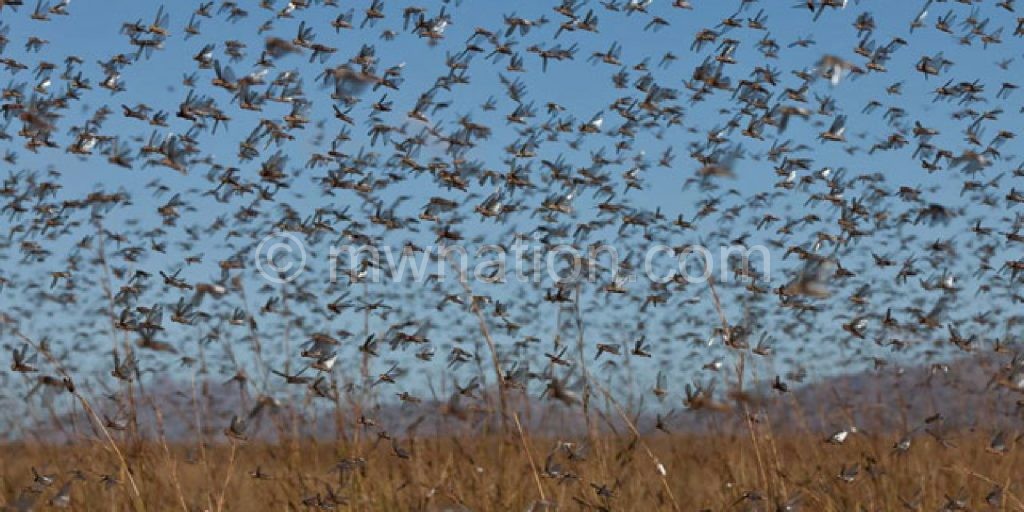Locusts damage 30ha maize crop
Experts have warned that the recently reported locust outbreak in Nsanje under the Shire Valley Agriculture Division (ADD) has the potential to go beyond the district if not contained as the locust swarm is proving to be unstoppable.
The locusts have so far destroyed 30 hectares of maize crop and are attacking different areas in the district.
During a visit to the area yesterday, The Nation learnt that the swarm has been reported in Bangula, precisely at Magoti Extension Planning Area (EPA), about 30 kilometres (km) away from Nyamula Irrigation Scheme where the first case was reported on July 22 2016.
Before Bangula where the swarm hit yesterday morning, the locust had also attacked crops, mostly maize, at Ntolongo B and Nyapilulu irrigation schemes under Mpasa EPA.
Rodrick Mphamba, an Agriculture Extension Development Officer (Aedo) at Mpasa EPA, said in an interview that as of yesterday, they had lost five and three hectares of maize crop at Nyamula and Nyapilulu irrigation schemes respectively.
He said: “A total of 26 farmers have lost their crops to the damage and there are fears that the swarm might return because it continues to move from one area to another. It was first spotted in Nyamula, then recorded on the bare grounds in Traditional Authority [T/A] Tengani before landing in Saikira area.
“It then flew back to Mozambique. When we thought it was gone, the swarm was seen at Chazuka on Monday and now is in Bangula where we also have big irrigation schemes.”
Mphamba also said the swarm is about two kilometres long and is taking about 30 minutes to cross an area.
Shire Valley ADD principal crop protection officer Ringstone Taibu said the swarm is not Red Locust as earlier announced, but African Locust.
He said in addition to the eight hectares, the locusts have also destroyed 10 hectares of maize crop at Dzunde EPA, taking the total loss to 28 hectares, excluding the yet-to-be documented damaged.
“A total of 20 hectares was affected, but only 10 destroyed. The other hectare was saved because people were informed about the outbreak earlier and were spending days in their farms and they managed to disturb its attack,” said Taibu.
Taibu did not play down the impact of the attack, saying being a flying pest, it poses serious threats because it can cover a larger area within a small space of time and they cannot limit the area that can be affected.
He said: “In some areas, the swarm was intercepted before landing. People had to shout, throw sand in the air and use tree branches. Our plan is not to destroy the insects, but deal with the breeding grounds.”
However, the success of this formula is dependent on Mozambique, the source of the locusts, said Taibu.
He said Malawi is currently awaiting the intervention of the International Red Locust Control Organisation for Central and Southern Africa (Irlcocsa) which has been in Tanzania fighting some crop pests and they expect that next will be Malawi.
Said Taibu: “For the meantime, government has provided us with 400 litres of cypermethein chemical. This does not kill the locusts, but produces a smell that scares locusts. Its effect lasts for two weeks and we are sure by the end of that period Irlcocsa will have intervened with aerial sprays. The locusts are targeting young maize plants and we will be targeting these with our sprays.”
Our visit to Nyamula Irrigation Scheme established that the spraying had not begun and farmers are living in fear and panic.
Nyamula Village Protection Committee (VPC) chairperson Mark Kalula said they are spending the whole day at the farm and others sleeping in the fields ready to intercept the swarm.
Shire Valley ADD has since intensified sensitisation campaigns at Nyachilenga, Zonde, Magoti Livuzu and Makhanga EPAs.
Last week, Ministry of Agriculture, Irrigation and Water Development Principal Secretary Erica Maganga issued a statement informing the public about the outbreak of locusts in Nsanje.
The ministry said the locust swarms can cause widespread and severe damage to crops such as maize, millet, sorghum, wheat, sugarcane, banana and even orchard trees.
Illovo Sugar (Malawi) Limited’s Nchalo Estate in Chikwawa, one of the country’s two vast sugar estates where government contracted the private sector to grow maize under irrigation to minimize food imports, has not been affected as the locust swarms are restricted to Nsanje in the meantime.
The locust swarms have come at a time the country is reeling from food shortage owing to reduced harvest following combined effects of prolonged dry spells and drought in some parts of the country. About 6.5 million of the country’s estimated 12 7.8 million people are in need of food aid.
7.8 million people are in need of food aid.





